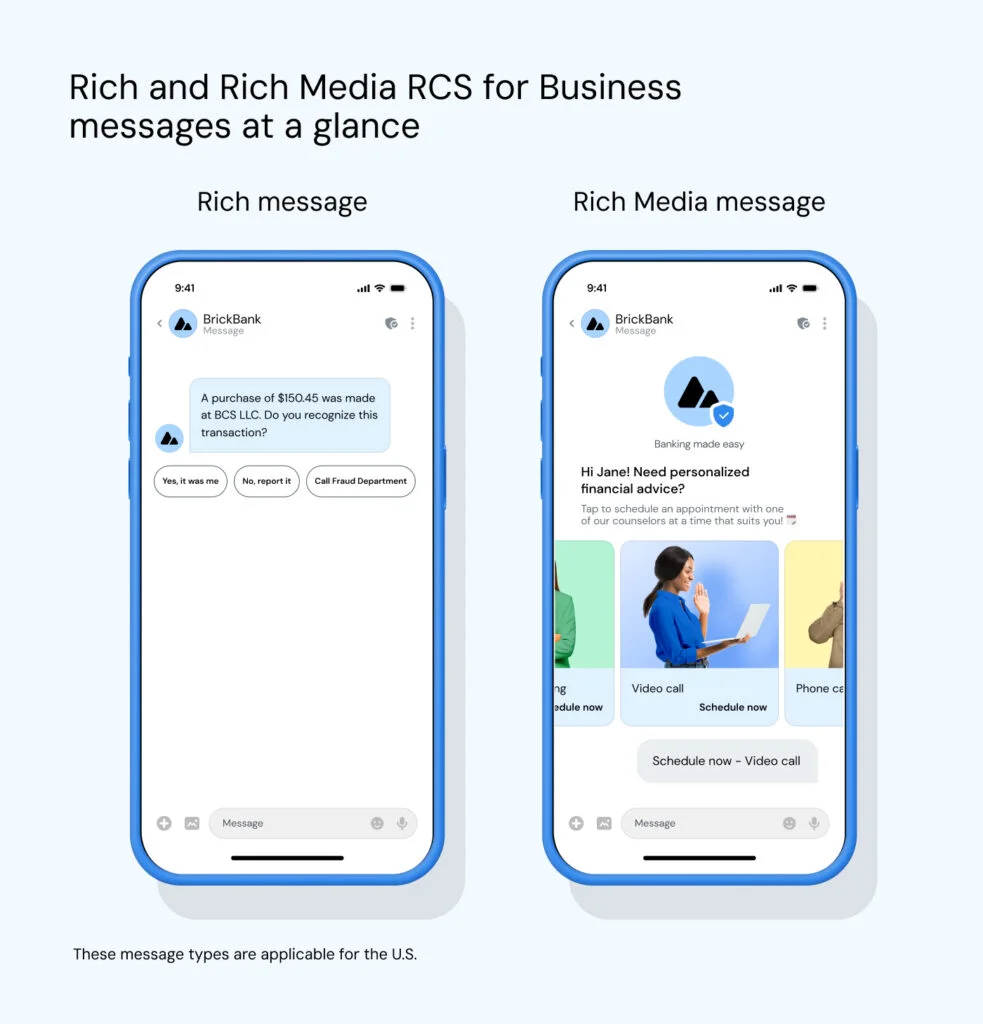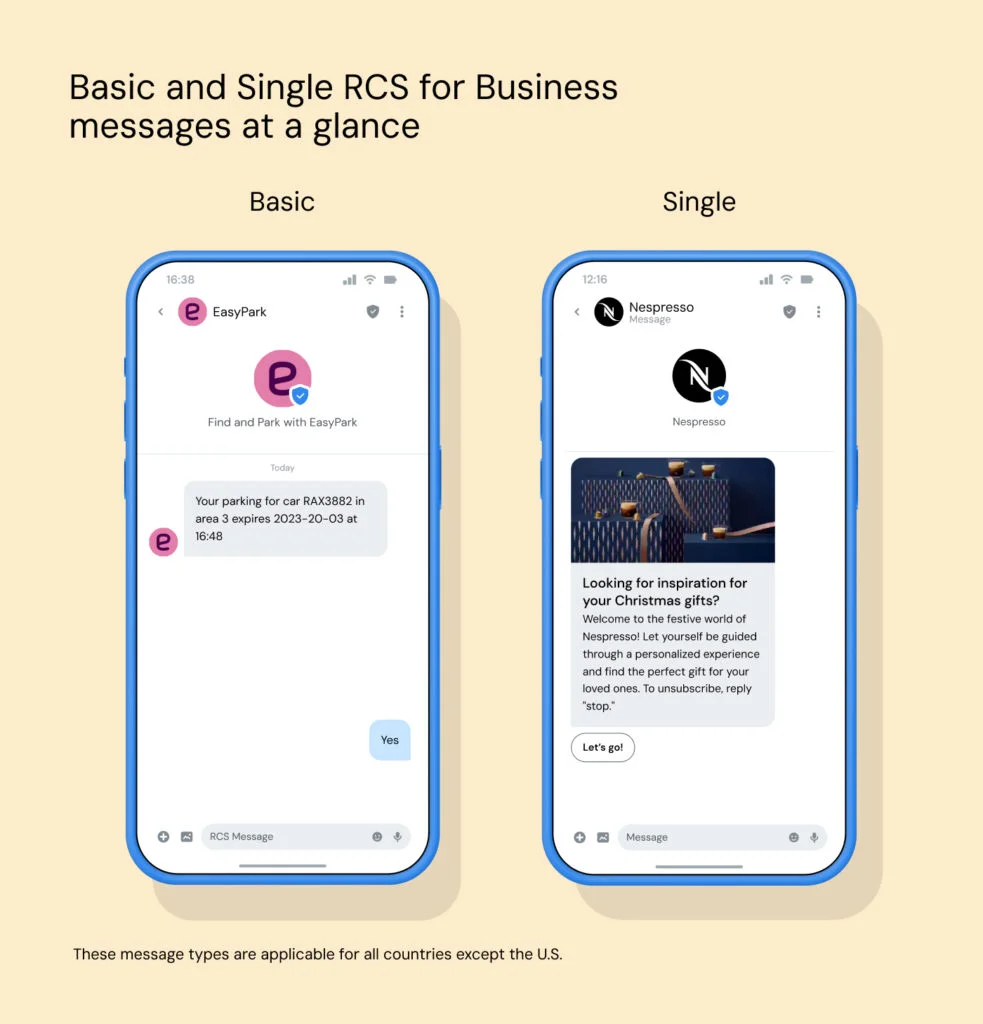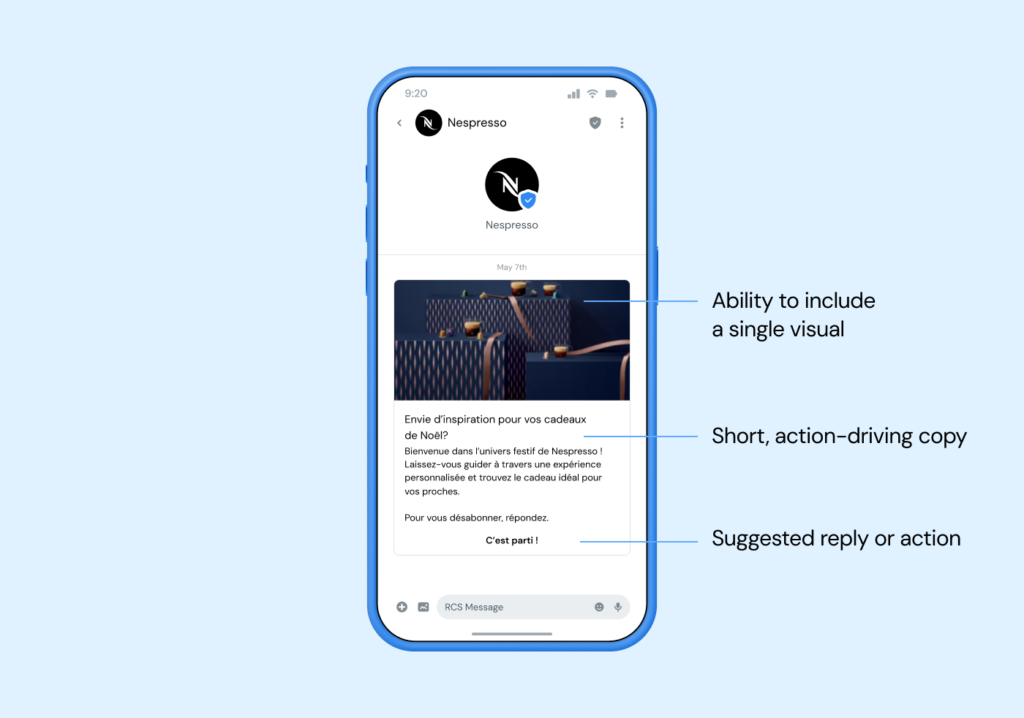Insights, Products
Types of RCS for Business messages and how to use them

Insights, Products

It finally happened: Apple’s iOS 26 has broadened Rich Communication Services (RCS) support for iPhones, and businesses are taking notice.
RCS for Business (previously called “RBM”) give businesses a way to send branded, verified RCS messages right inside the default mobile messaging inbox that consumers already use. Unlike SMS, these messages can include images, buttons, richer layouts, and even read receipts.
If you haven’t explored RCS for your business yet, now’s the perfect time. Let’s break down the types of RCS messages available to businesses and look at how leading brands are using them to boost engagement and sales.
Businesses in the U.S. can choose between two types of RCS messages: Rich messages and Rich Media messages. The exact definitions and billing models can vary slightly by carrier, but here’s the simple breakdown.
Rich messages are great for straightforward communication where you want to keep things short and clear. They’re best for quick updates or alerts where you don’t need to add a lot of extra content.
A Rich message includes:
When you want to make your RCS message stand out, Rich Media is the way to go. These messages give brands more flexibility because they allow for visuals, interactivity, and more text.
A Rich Media message includes:
Rich Media messages are great for marketing campaigns, product showcases, or any time visuals help tell the story and drive action.
Let’s take a look at what a Rich message and a Rich Media message look like side-by-side.

Outside, the U.S., carriers typically classify RCS for Business messages as either Basic messages or Single messages.
A Basic message keeps things light and easy to set up.
A Basic message includes:
Basic messages are perfect for sending one-off updates, like one-time passwords, that don’t need a response. These messages are great for delivering announcements about a limited-time offer or an upcoming event, and you always have the option to include URL previews that drive traffic to your website or landing pages.
If your message is longer than 160 characters, it becomes a Single message.
A Single message includes:
Single messages are great for marketing campaigns or product showcases. They’re ideal for driving immediate action because they can include personalized visuals that showcase products or offer promotions. Plus, you can use them to guide customers toward specific actions, like creating a calendar event, finding locations, dialing numbers, or opening URLs.
Let’s take a look at what a Basic message and a Single message look like side-by-side.

With minimal backend effort required, Single messages are a great option for businesses wanting to quickly boost interactions and conversions.
Next, we’ll look at a few real-world examples of how brands are using these different RCS message types to connect with their customers.
So, what does this all look like in the real world? Let’s look at how two brands are already using RCS to make everyday customer interactions more secure and effective.
EasyPark Group, a leading digital parking app, used to rely on multiple vendors to deliver SMS parking reminders across multiple markets. To streamline their messaging, they chose Sinch as their sole provider for SMS.
Alex Keynes, Head of Product – Driver’s Experience at EasyPark, shared how the Sinch team championed upgrading SMS to RCS Basic messages for RCS-compatible devices. That meant drivers could clearly see the verified EasyPark brand as the sender, and know that the reminders were real and secure.
For drivers without RCS, nothing changed – they still received SMS reminders, meaning every driver would get important notifications.
As Alex mentions, the transition required minimal effort from EasyPark to set up and created no friction for them or their users. Because this initial campaign took place in Germany, messages were sent as Basic messages, but had EasyPark been in the U.S. they could do a similar thing with the Rich message type.
Nespresso, the premium coffee brand, wanted to showcase holiday gift ideas in a personalized, interactive way. Using Single messages, they sent a visual with short, compelling copy and suggested replies that could turn into a conversation if the recipient replied.

The results? The RCS messages achieved a 73% read rate and had over twice the click rate of their SMS campaigns. The visuals and interactive buttons clearly inspired customers to take action. And the real magic? Those replies could turn into conversations – one of the most powerful features of RCS.
Because this campaign ran in France, the messages were classified as Single messages. In the U.S., this type of campaign would fall under the Rich Media category.
As you’re weighing the pros and cons of the different RCS message types and their potential benefits for your business, keep these factors in mind:
Apple’s support for RCS is bringing brands a powerful way to connect with customers directly in their native mobile inboxes.
As major carriers adopt [RCS], we’re moving toward that 100% reach metric that makes SMS so powerful, but with all the added capabilities of RCS.

The possibilities for RCS are huge, and businesses that jump on board now will have a lot to gain.
If you’re already sold on RCS but need to get the rest of your team on board, we’ve got you covered. Download our actionable guide to learn how to make a strong business case for RCS, complete with a ready-to-use template to help you get started right away.
Or, if you’re ready to get started with RCS, let’s chat. Our team of experts can’t wait to help you explore its endless opportunities for mobile engagement.